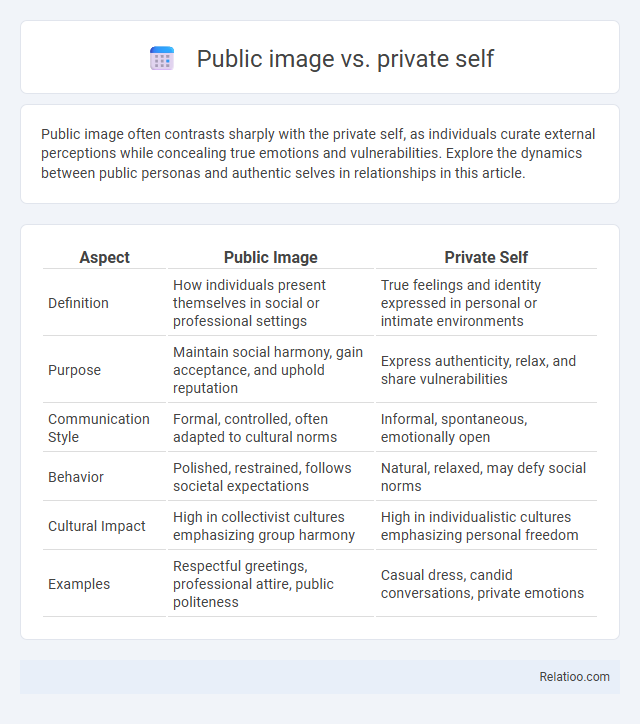Public image often contrasts sharply with the private self, as individuals curate external perceptions while concealing true emotions and vulnerabilities. Explore the dynamics between public personas and authentic selves in relationships in this article.
Table of Comparison
| Aspect | Public Image | Private Self |
|---|---|---|
| Definition | How individuals present themselves in social or professional settings | True feelings and identity expressed in personal or intimate environments |
| Purpose | Maintain social harmony, gain acceptance, and uphold reputation | Express authenticity, relax, and share vulnerabilities |
| Communication Style | Formal, controlled, often adapted to cultural norms | Informal, spontaneous, emotionally open |
| Behavior | Polished, restrained, follows societal expectations | Natural, relaxed, may defy social norms |
| Cultural Impact | High in collectivist cultures emphasizing group harmony | High in individualistic cultures emphasizing personal freedom |
| Examples | Respectful greetings, professional attire, public politeness | Casual dress, candid conversations, private emotions |
Understanding Public Image and Private Self
Understanding public image involves recognizing how others perceive your outward behaviors, appearance, and communication in social or professional contexts. Your private self consists of your true beliefs, feelings, and values that may remain hidden from public view. Balancing these aspects helps shape your reputation, which is the collective judgment others form based on both your public image and the consistency with your private self.
The Origins of Our Dual Personas
The origins of our dual personas stem from the need to navigate different social contexts, where the public image serves as a crafted representation designed to meet societal expectations. The private self contains authentic thoughts and emotions, often shielded from external judgment, creating a contrast between outward behavior and inner reality. Reputation emerges as a social construct built from the interplay between public image and the perceptions of others, influencing how individuals are treated and how they perceive themselves.
Social Media’s Role in Shaping Public Image
Social media platforms significantly influence public image by curating and broadcasting carefully selected aspects of an individual's life, often blurring the lines between public persona and private self. The algorithm-driven visibility amplifies positive content while sometimes suppressing or distorting reality, impacting reputation in both personal and professional realms. Continuous online engagement and user-generated feedback further solidify or challenge the constructed public image, making social media a critical force in reputation management and identity expression.
Psychological Impact of Maintaining Two Selves
Maintaining a public image that differs from your private self can create significant psychological stress, often leading to feelings of inner conflict and emotional exhaustion. This dissonance between the identities affects mental health by fostering anxiety, reduced self-esteem, and a persistent fear of exposure or judgment. Balancing reputation management with authenticity is crucial to mitigate the negative impact on your overall psychological well-being.
Navigating Authenticity in a Public World
Navigating authenticity in a public world requires balancing your public image, private self, and reputation with intentional clarity. Your public image is the curated persona shared with society, while the private self contains genuine thoughts and emotions often shielded from public view. Maintaining a consistent reputation hinges on aligning these elements to foster trust and credibility without compromising your true identity.
Cultural Influences on Self-Presentation
Cultural influences significantly shape the distinctions between public image, private self, and reputation by dictating how individuals present themselves in various social contexts. Your public image often conforms to societal norms and expectations, while the private self remains more authentic and unconstrained by cultural pressures. Reputation emerges from the consistent alignment or conflict between these expressions within a community that values conformity, honor, or individuality differently depending on cultural background.
Coping with the Pressure to Conform
Coping with the pressure to conform involves managing the differences between public image, private self, and reputation by establishing clear personal boundaries and authentic self-expression. Individuals often face a conflict when societal expectations challenge their private identities, leading to stress and the need for resilience strategies such as mindfulness and selective disclosure. Developing a strong sense of self-worth independent of public perception helps maintain mental health while navigating external demands to align with accepted norms.
Balancing Professional and Personal Personas
Balancing professional and personal personas requires managing the public image, private self, and reputation with clarity and consistency. A public image crafted through social media and professional networks influences external perceptions, while the private self reflects authentic values and emotions that shape personal well-being. Maintaining reputation hinges on aligning actions and communication across both spheres to build trust and credibility in professional and personal relationships.
Effects of Public Scrutiny on Private Life
Public scrutiny often blurs the boundary between public image and private self, leading to increased stress and challenges in maintaining personal authenticity. Constant observation and judgment by media and society can damage an individual's reputation, affecting personal relationships and mental health. The invasive nature of public scrutiny forces many to carefully curate their public image, sometimes at the expense of their true private identity.
Embracing Vulnerability for True Self-Expression
Public image often reflects curated impressions designed to meet societal expectations, while the private self reveals authentic emotions and thoughts hidden from external judgment. Embracing vulnerability enables individuals to bridge the gap between their public image and private self, fostering genuine self-expression and deeper connections. True reputation evolves not from perfection but from the courage to reveal imperfections and authenticity in interpersonal relationships.

Infographic: Public image vs Private self
 relatioo.com
relatioo.com